Hypothetical Questions on Negligent Misstatement and Australian Consumer Law
VerifiedAdded on 2023/06/07
|14
|3308
|120
AI Summary
This assignment answers hypothetical questions on issues related to negligent misstatement and Australian consumer law. It includes an analysis of the applicable laws, case examples, and their application to the given scenarios.
Contribute Materials
Your contribution can guide someone’s learning journey. Share your
documents today.
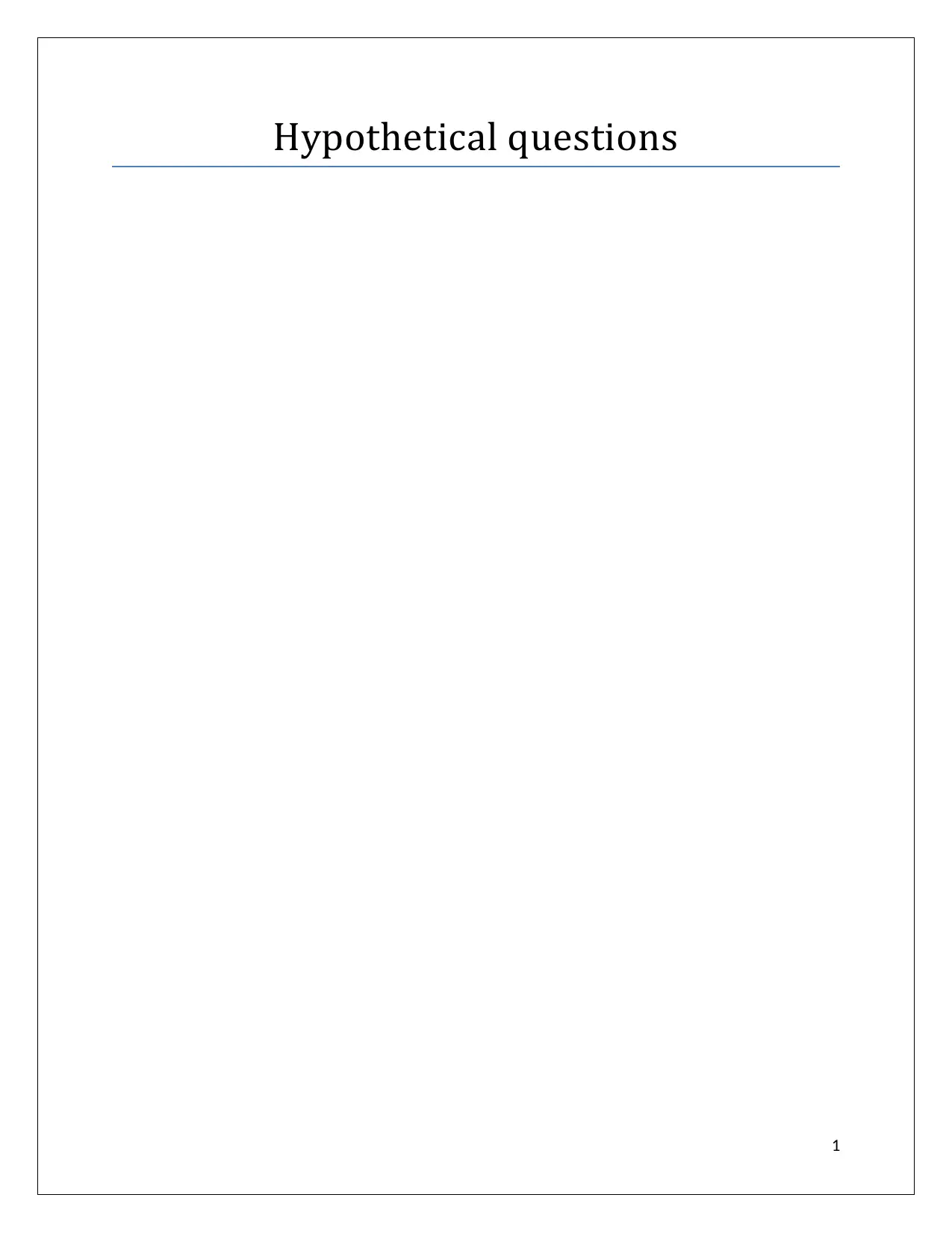
Hypothetical questions
1
1
Secure Best Marks with AI Grader
Need help grading? Try our AI Grader for instant feedback on your assignments.
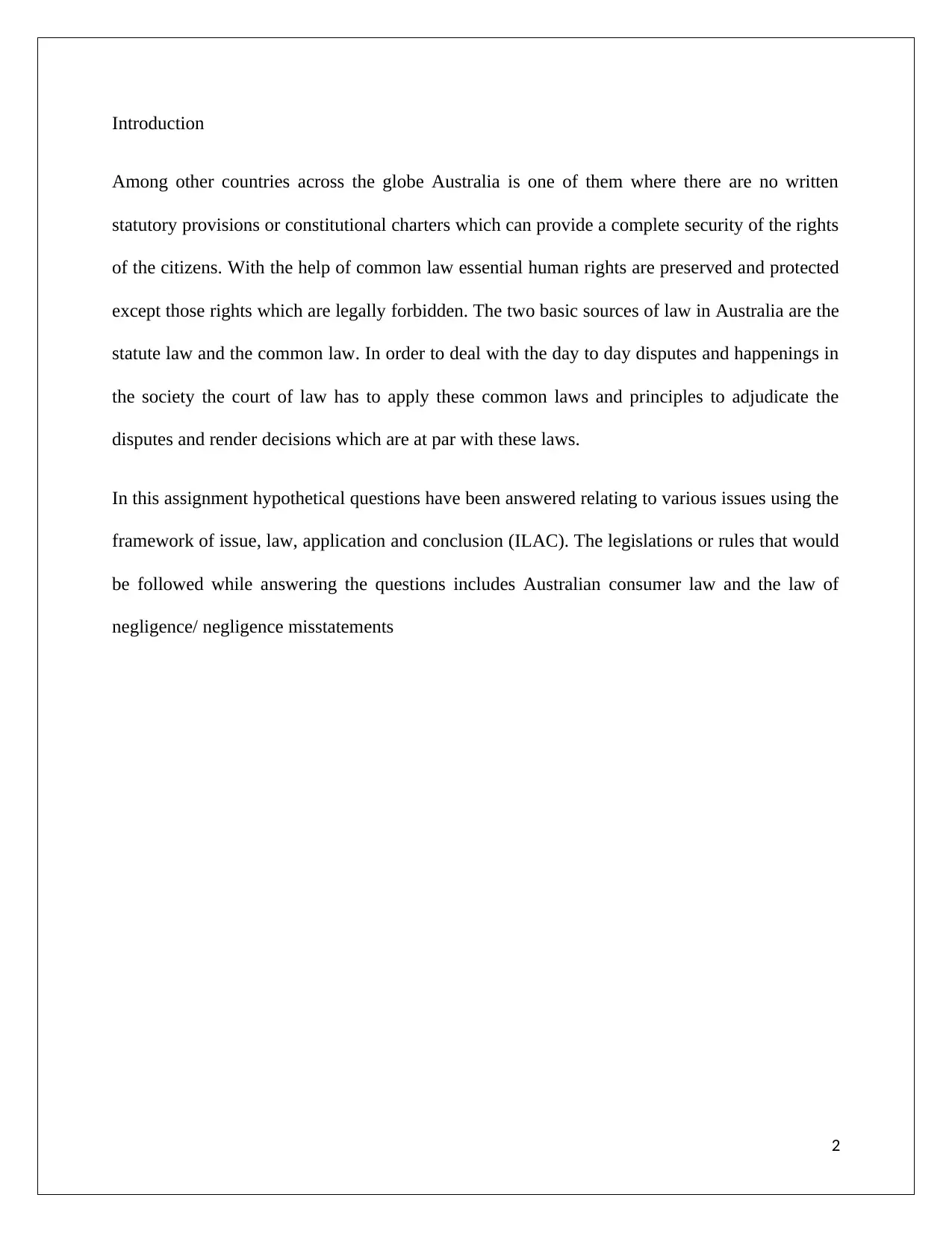
Introduction
Among other countries across the globe Australia is one of them where there are no written
statutory provisions or constitutional charters which can provide a complete security of the rights
of the citizens. With the help of common law essential human rights are preserved and protected
except those rights which are legally forbidden. The two basic sources of law in Australia are the
statute law and the common law. In order to deal with the day to day disputes and happenings in
the society the court of law has to apply these common laws and principles to adjudicate the
disputes and render decisions which are at par with these laws.
In this assignment hypothetical questions have been answered relating to various issues using the
framework of issue, law, application and conclusion (ILAC). The legislations or rules that would
be followed while answering the questions includes Australian consumer law and the law of
negligence/ negligence misstatements
2
Among other countries across the globe Australia is one of them where there are no written
statutory provisions or constitutional charters which can provide a complete security of the rights
of the citizens. With the help of common law essential human rights are preserved and protected
except those rights which are legally forbidden. The two basic sources of law in Australia are the
statute law and the common law. In order to deal with the day to day disputes and happenings in
the society the court of law has to apply these common laws and principles to adjudicate the
disputes and render decisions which are at par with these laws.
In this assignment hypothetical questions have been answered relating to various issues using the
framework of issue, law, application and conclusion (ILAC). The legislations or rules that would
be followed while answering the questions includes Australian consumer law and the law of
negligence/ negligence misstatements
2
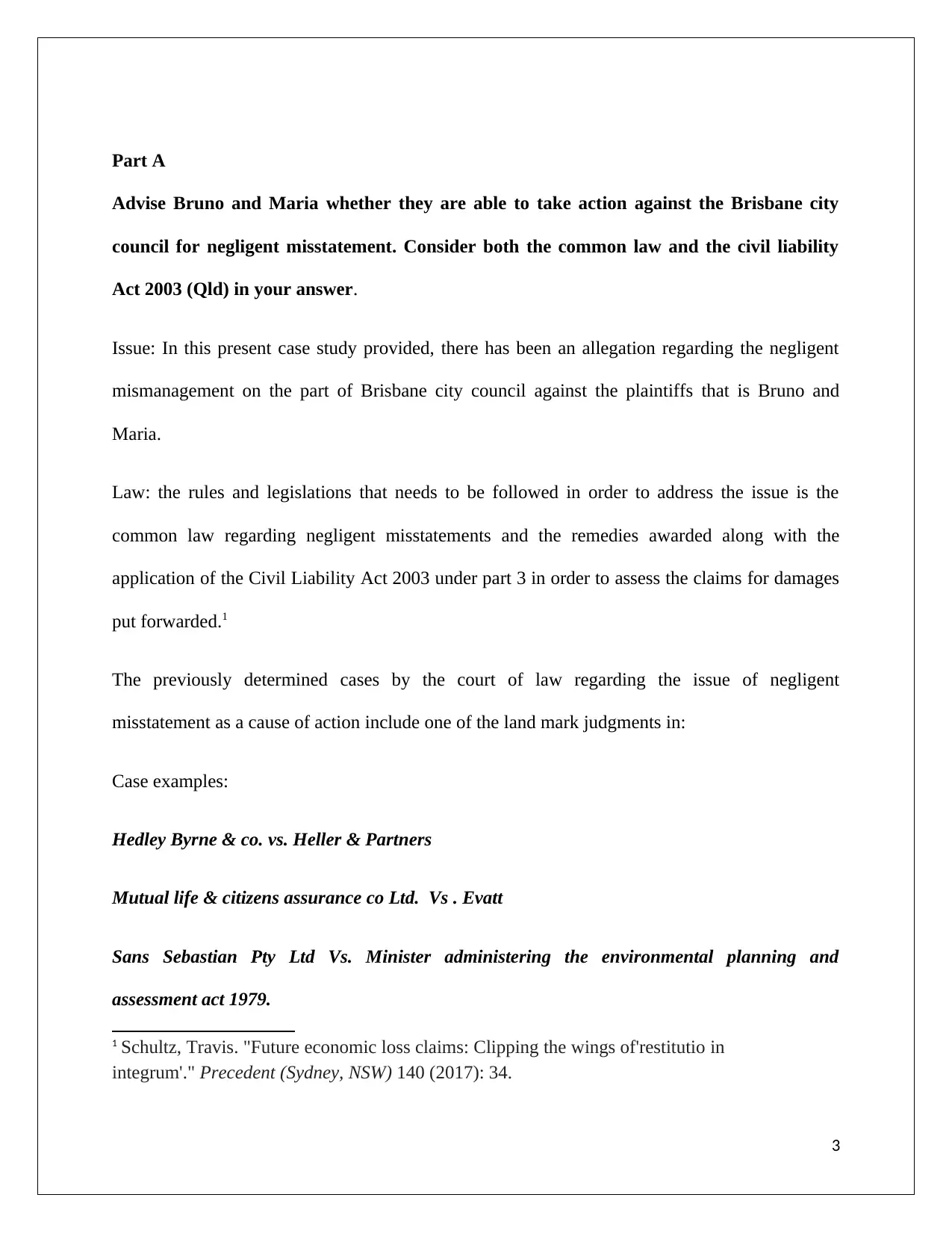
Part A
Advise Bruno and Maria whether they are able to take action against the Brisbane city
council for negligent misstatement. Consider both the common law and the civil liability
Act 2003 (Qld) in your answer.
Issue: In this present case study provided, there has been an allegation regarding the negligent
mismanagement on the part of Brisbane city council against the plaintiffs that is Bruno and
Maria.
Law: the rules and legislations that needs to be followed in order to address the issue is the
common law regarding negligent misstatements and the remedies awarded along with the
application of the Civil Liability Act 2003 under part 3 in order to assess the claims for damages
put forwarded.1
The previously determined cases by the court of law regarding the issue of negligent
misstatement as a cause of action include one of the land mark judgments in:
Case examples:
Hedley Byrne & co. vs. Heller & Partners
Mutual life & citizens assurance co Ltd. Vs . Evatt
Sans Sebastian Pty Ltd Vs. Minister administering the environmental planning and
assessment act 1979.
1 Schultz, Travis. "Future economic loss claims: Clipping the wings of'restitutio in
integrum'." Precedent (Sydney, NSW) 140 (2017): 34.
3
Advise Bruno and Maria whether they are able to take action against the Brisbane city
council for negligent misstatement. Consider both the common law and the civil liability
Act 2003 (Qld) in your answer.
Issue: In this present case study provided, there has been an allegation regarding the negligent
mismanagement on the part of Brisbane city council against the plaintiffs that is Bruno and
Maria.
Law: the rules and legislations that needs to be followed in order to address the issue is the
common law regarding negligent misstatements and the remedies awarded along with the
application of the Civil Liability Act 2003 under part 3 in order to assess the claims for damages
put forwarded.1
The previously determined cases by the court of law regarding the issue of negligent
misstatement as a cause of action include one of the land mark judgments in:
Case examples:
Hedley Byrne & co. vs. Heller & Partners
Mutual life & citizens assurance co Ltd. Vs . Evatt
Sans Sebastian Pty Ltd Vs. Minister administering the environmental planning and
assessment act 1979.
1 Schultz, Travis. "Future economic loss claims: Clipping the wings of'restitutio in
integrum'." Precedent (Sydney, NSW) 140 (2017): 34.
3
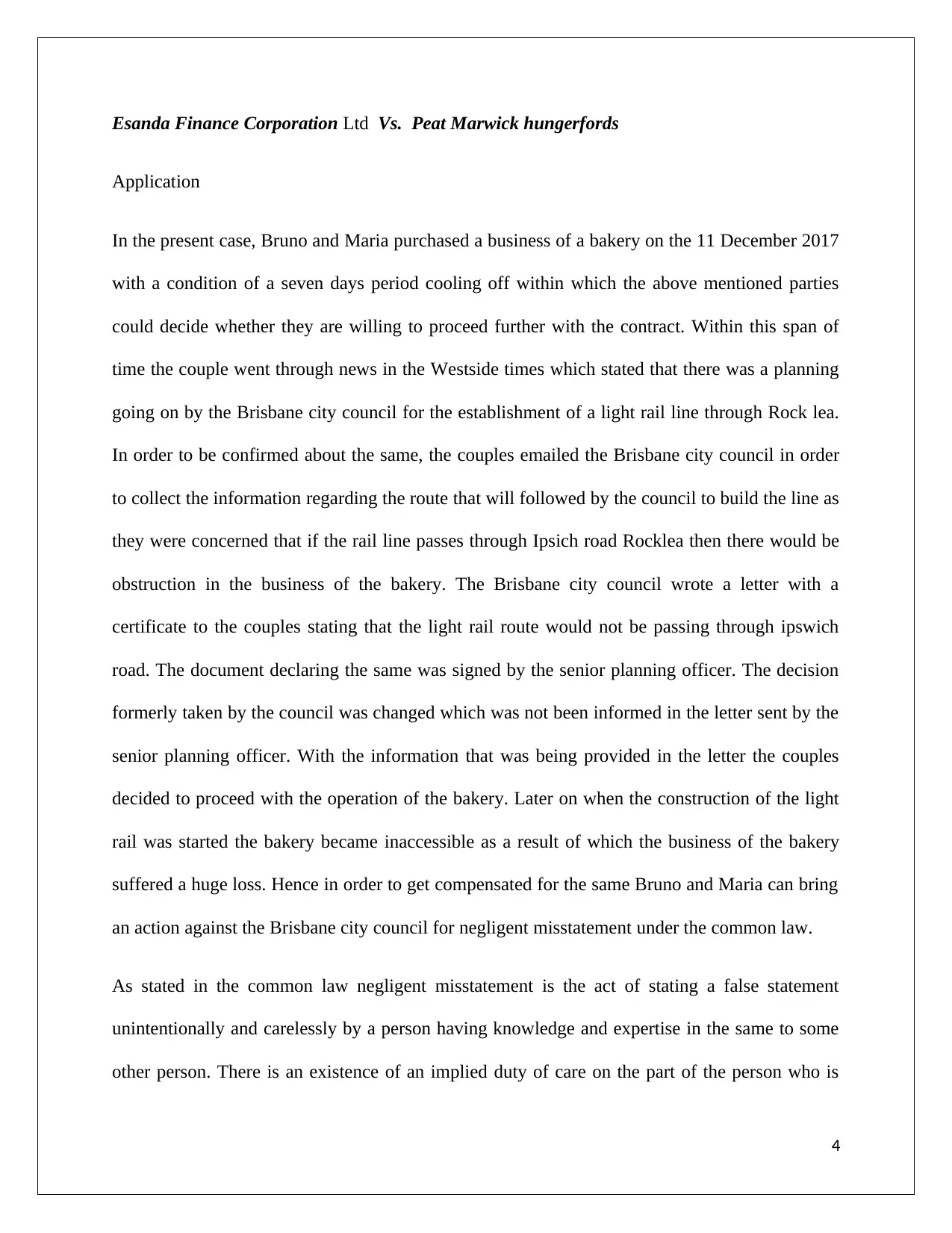
Esanda Finance Corporation Ltd Vs. Peat Marwick hungerfords
Application
In the present case, Bruno and Maria purchased a business of a bakery on the 11 December 2017
with a condition of a seven days period cooling off within which the above mentioned parties
could decide whether they are willing to proceed further with the contract. Within this span of
time the couple went through news in the Westside times which stated that there was a planning
going on by the Brisbane city council for the establishment of a light rail line through Rock lea.
In order to be confirmed about the same, the couples emailed the Brisbane city council in order
to collect the information regarding the route that will followed by the council to build the line as
they were concerned that if the rail line passes through Ipsich road Rocklea then there would be
obstruction in the business of the bakery. The Brisbane city council wrote a letter with a
certificate to the couples stating that the light rail route would not be passing through ipswich
road. The document declaring the same was signed by the senior planning officer. The decision
formerly taken by the council was changed which was not been informed in the letter sent by the
senior planning officer. With the information that was being provided in the letter the couples
decided to proceed with the operation of the bakery. Later on when the construction of the light
rail was started the bakery became inaccessible as a result of which the business of the bakery
suffered a huge loss. Hence in order to get compensated for the same Bruno and Maria can bring
an action against the Brisbane city council for negligent misstatement under the common law.
As stated in the common law negligent misstatement is the act of stating a false statement
unintentionally and carelessly by a person having knowledge and expertise in the same to some
other person. There is an existence of an implied duty of care on the part of the person who is
4
Application
In the present case, Bruno and Maria purchased a business of a bakery on the 11 December 2017
with a condition of a seven days period cooling off within which the above mentioned parties
could decide whether they are willing to proceed further with the contract. Within this span of
time the couple went through news in the Westside times which stated that there was a planning
going on by the Brisbane city council for the establishment of a light rail line through Rock lea.
In order to be confirmed about the same, the couples emailed the Brisbane city council in order
to collect the information regarding the route that will followed by the council to build the line as
they were concerned that if the rail line passes through Ipsich road Rocklea then there would be
obstruction in the business of the bakery. The Brisbane city council wrote a letter with a
certificate to the couples stating that the light rail route would not be passing through ipswich
road. The document declaring the same was signed by the senior planning officer. The decision
formerly taken by the council was changed which was not been informed in the letter sent by the
senior planning officer. With the information that was being provided in the letter the couples
decided to proceed with the operation of the bakery. Later on when the construction of the light
rail was started the bakery became inaccessible as a result of which the business of the bakery
suffered a huge loss. Hence in order to get compensated for the same Bruno and Maria can bring
an action against the Brisbane city council for negligent misstatement under the common law.
As stated in the common law negligent misstatement is the act of stating a false statement
unintentionally and carelessly by a person having knowledge and expertise in the same to some
other person. There is an existence of an implied duty of care on the part of the person who is
4
Paraphrase This Document
Need a fresh take? Get an instant paraphrase of this document with our AI Paraphraser
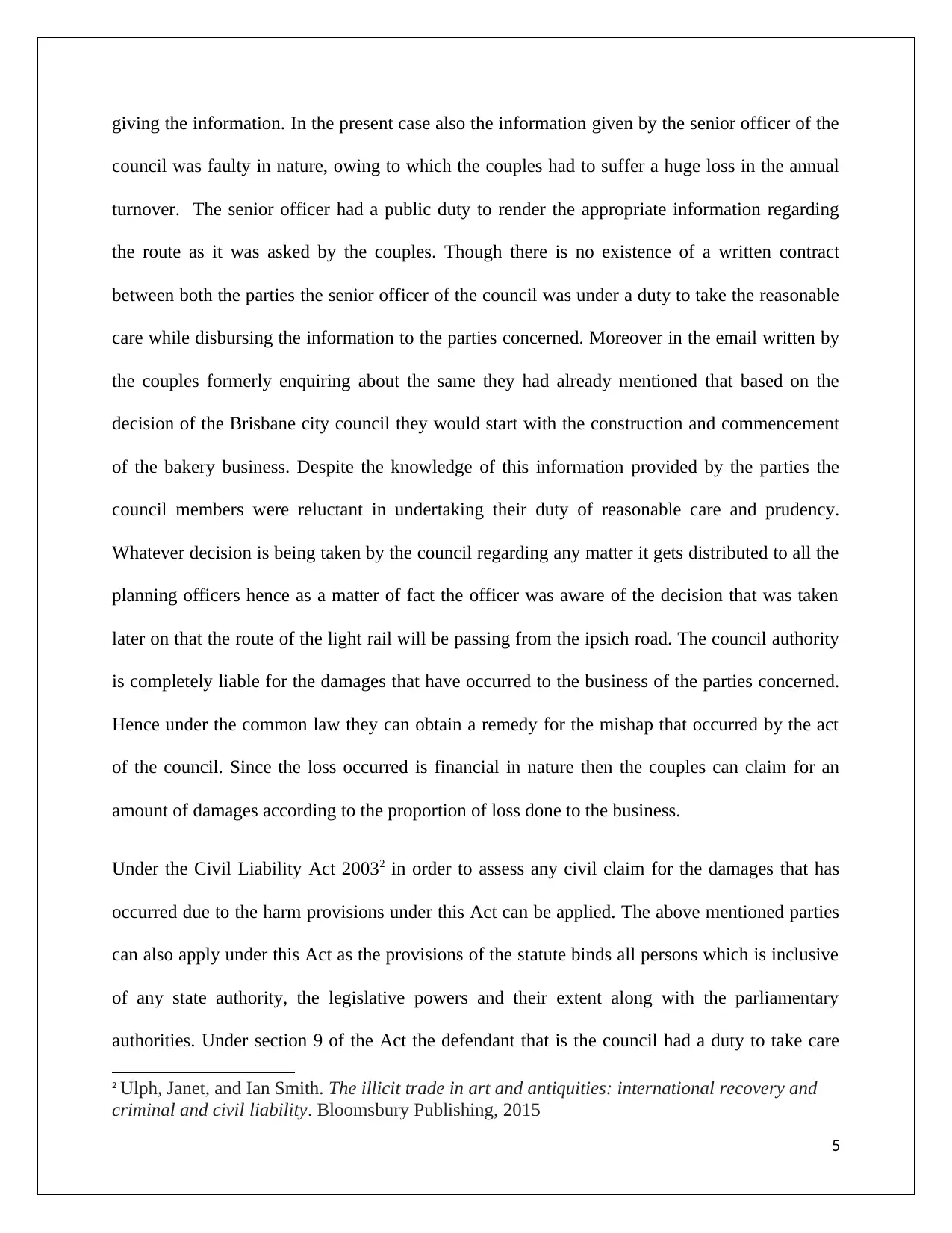
giving the information. In the present case also the information given by the senior officer of the
council was faulty in nature, owing to which the couples had to suffer a huge loss in the annual
turnover. The senior officer had a public duty to render the appropriate information regarding
the route as it was asked by the couples. Though there is no existence of a written contract
between both the parties the senior officer of the council was under a duty to take the reasonable
care while disbursing the information to the parties concerned. Moreover in the email written by
the couples formerly enquiring about the same they had already mentioned that based on the
decision of the Brisbane city council they would start with the construction and commencement
of the bakery business. Despite the knowledge of this information provided by the parties the
council members were reluctant in undertaking their duty of reasonable care and prudency.
Whatever decision is being taken by the council regarding any matter it gets distributed to all the
planning officers hence as a matter of fact the officer was aware of the decision that was taken
later on that the route of the light rail will be passing from the ipsich road. The council authority
is completely liable for the damages that have occurred to the business of the parties concerned.
Hence under the common law they can obtain a remedy for the mishap that occurred by the act
of the council. Since the loss occurred is financial in nature then the couples can claim for an
amount of damages according to the proportion of loss done to the business.
Under the Civil Liability Act 20032 in order to assess any civil claim for the damages that has
occurred due to the harm provisions under this Act can be applied. The above mentioned parties
can also apply under this Act as the provisions of the statute binds all persons which is inclusive
of any state authority, the legislative powers and their extent along with the parliamentary
authorities. Under section 9 of the Act the defendant that is the council had a duty to take care
2 Ulph, Janet, and Ian Smith. The illicit trade in art and antiquities: international recovery and
criminal and civil liability. Bloomsbury Publishing, 2015
5
council was faulty in nature, owing to which the couples had to suffer a huge loss in the annual
turnover. The senior officer had a public duty to render the appropriate information regarding
the route as it was asked by the couples. Though there is no existence of a written contract
between both the parties the senior officer of the council was under a duty to take the reasonable
care while disbursing the information to the parties concerned. Moreover in the email written by
the couples formerly enquiring about the same they had already mentioned that based on the
decision of the Brisbane city council they would start with the construction and commencement
of the bakery business. Despite the knowledge of this information provided by the parties the
council members were reluctant in undertaking their duty of reasonable care and prudency.
Whatever decision is being taken by the council regarding any matter it gets distributed to all the
planning officers hence as a matter of fact the officer was aware of the decision that was taken
later on that the route of the light rail will be passing from the ipsich road. The council authority
is completely liable for the damages that have occurred to the business of the parties concerned.
Hence under the common law they can obtain a remedy for the mishap that occurred by the act
of the council. Since the loss occurred is financial in nature then the couples can claim for an
amount of damages according to the proportion of loss done to the business.
Under the Civil Liability Act 20032 in order to assess any civil claim for the damages that has
occurred due to the harm provisions under this Act can be applied. The above mentioned parties
can also apply under this Act as the provisions of the statute binds all persons which is inclusive
of any state authority, the legislative powers and their extent along with the parliamentary
authorities. Under section 9 of the Act the defendant that is the council had a duty to take care
2 Ulph, Janet, and Ian Smith. The illicit trade in art and antiquities: international recovery and
criminal and civil liability. Bloomsbury Publishing, 2015
5
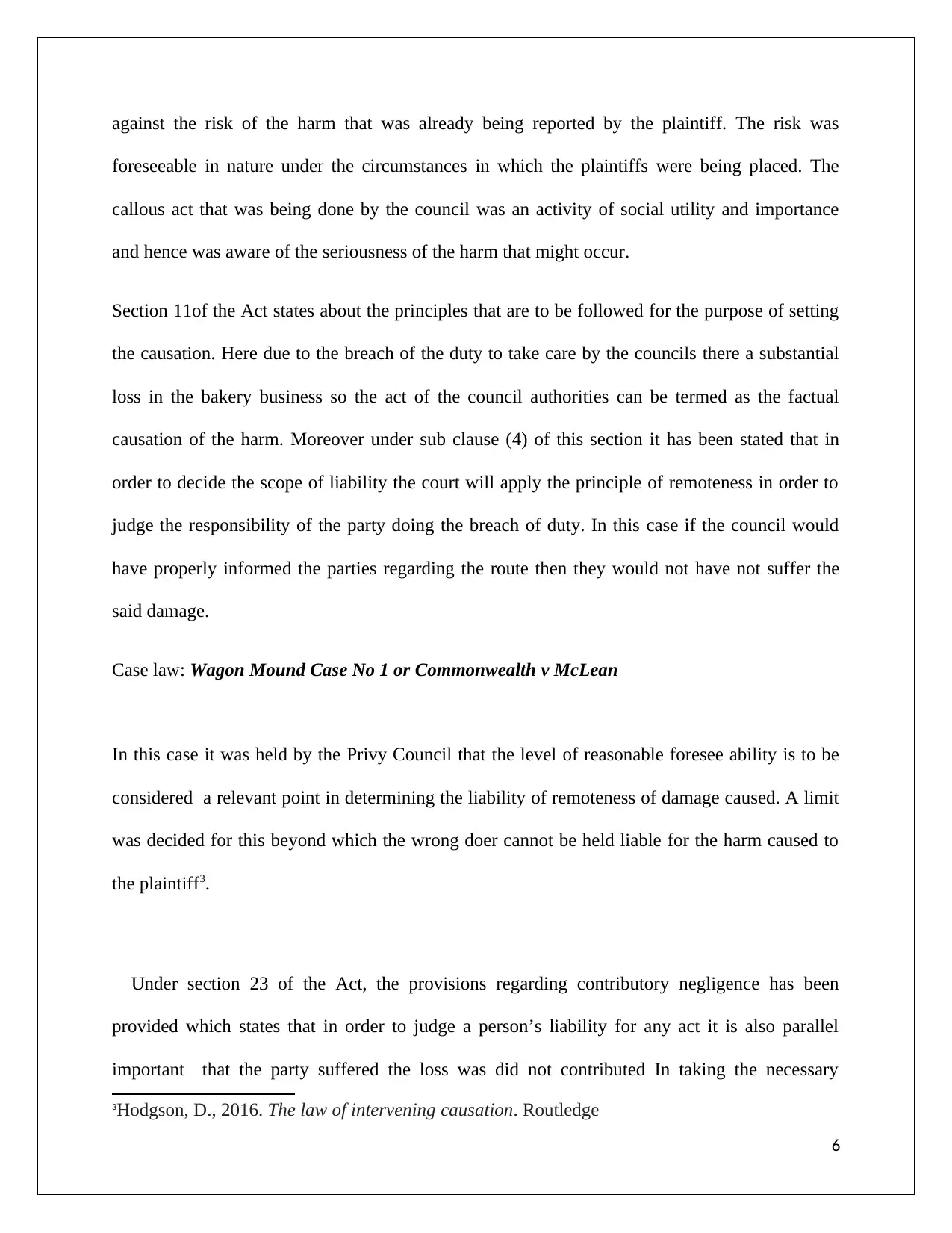
against the risk of the harm that was already being reported by the plaintiff. The risk was
foreseeable in nature under the circumstances in which the plaintiffs were being placed. The
callous act that was being done by the council was an activity of social utility and importance
and hence was aware of the seriousness of the harm that might occur.
Section 11of the Act states about the principles that are to be followed for the purpose of setting
the causation. Here due to the breach of the duty to take care by the councils there a substantial
loss in the bakery business so the act of the council authorities can be termed as the factual
causation of the harm. Moreover under sub clause (4) of this section it has been stated that in
order to decide the scope of liability the court will apply the principle of remoteness in order to
judge the responsibility of the party doing the breach of duty. In this case if the council would
have properly informed the parties regarding the route then they would not have not suffer the
said damage.
Case law: Wagon Mound Case No 1 or Commonwealth v McLean
In this case it was held by the Privy Council that the level of reasonable foresee ability is to be
considered a relevant point in determining the liability of remoteness of damage caused. A limit
was decided for this beyond which the wrong doer cannot be held liable for the harm caused to
the plaintiff3.
Under section 23 of the Act, the provisions regarding contributory negligence has been
provided which states that in order to judge a person’s liability for any act it is also parallel
important that the party suffered the loss was did not contributed In taking the necessary
3Hodgson, D., 2016. The law of intervening causation. Routledge
6
foreseeable in nature under the circumstances in which the plaintiffs were being placed. The
callous act that was being done by the council was an activity of social utility and importance
and hence was aware of the seriousness of the harm that might occur.
Section 11of the Act states about the principles that are to be followed for the purpose of setting
the causation. Here due to the breach of the duty to take care by the councils there a substantial
loss in the bakery business so the act of the council authorities can be termed as the factual
causation of the harm. Moreover under sub clause (4) of this section it has been stated that in
order to decide the scope of liability the court will apply the principle of remoteness in order to
judge the responsibility of the party doing the breach of duty. In this case if the council would
have properly informed the parties regarding the route then they would not have not suffer the
said damage.
Case law: Wagon Mound Case No 1 or Commonwealth v McLean
In this case it was held by the Privy Council that the level of reasonable foresee ability is to be
considered a relevant point in determining the liability of remoteness of damage caused. A limit
was decided for this beyond which the wrong doer cannot be held liable for the harm caused to
the plaintiff3.
Under section 23 of the Act, the provisions regarding contributory negligence has been
provided which states that in order to judge a person’s liability for any act it is also parallel
important that the party suffered the loss was did not contributed In taking the necessary
3Hodgson, D., 2016. The law of intervening causation. Routledge
6
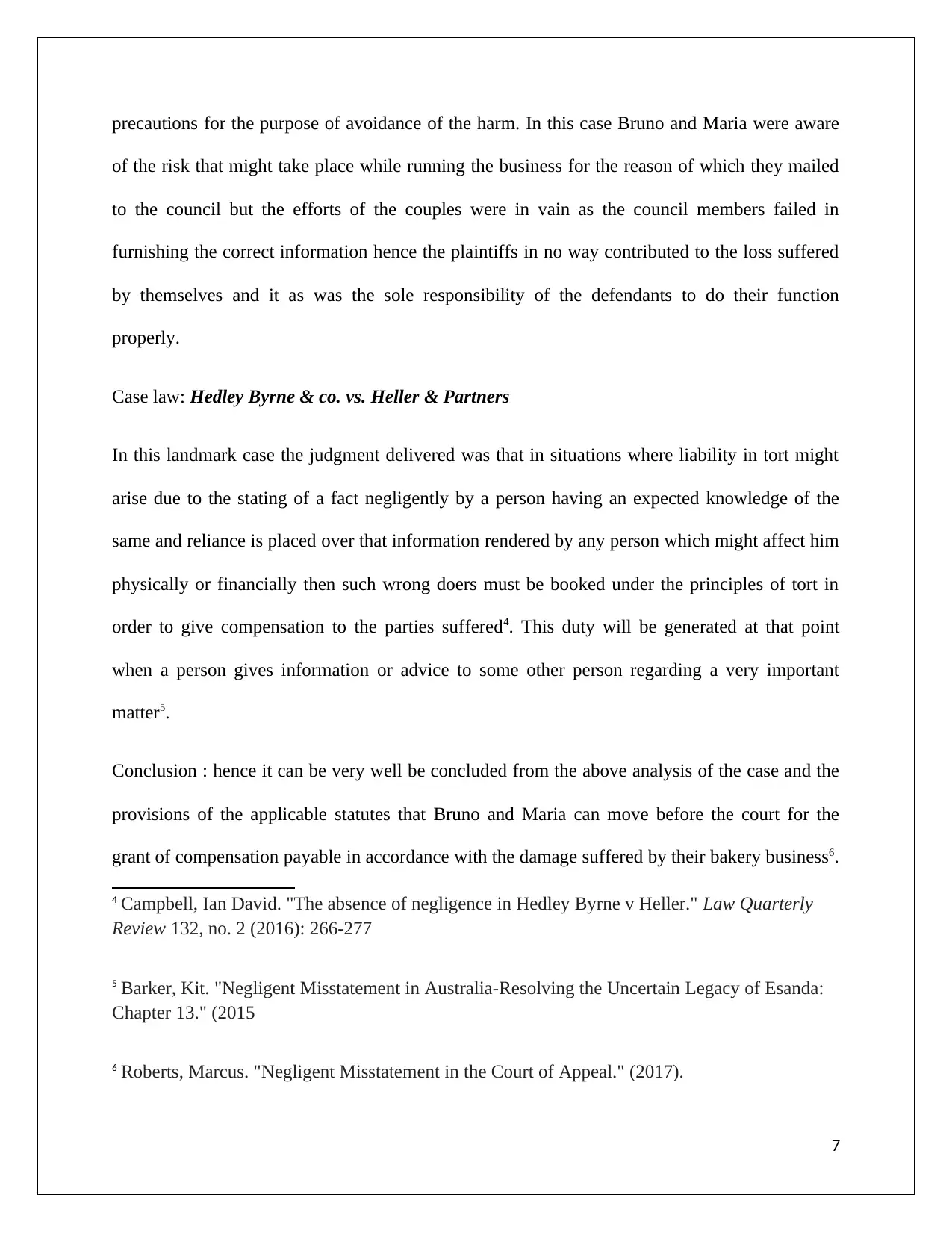
precautions for the purpose of avoidance of the harm. In this case Bruno and Maria were aware
of the risk that might take place while running the business for the reason of which they mailed
to the council but the efforts of the couples were in vain as the council members failed in
furnishing the correct information hence the plaintiffs in no way contributed to the loss suffered
by themselves and it as was the sole responsibility of the defendants to do their function
properly.
Case law: Hedley Byrne & co. vs. Heller & Partners
In this landmark case the judgment delivered was that in situations where liability in tort might
arise due to the stating of a fact negligently by a person having an expected knowledge of the
same and reliance is placed over that information rendered by any person which might affect him
physically or financially then such wrong doers must be booked under the principles of tort in
order to give compensation to the parties suffered4. This duty will be generated at that point
when a person gives information or advice to some other person regarding a very important
matter5.
Conclusion : hence it can be very well be concluded from the above analysis of the case and the
provisions of the applicable statutes that Bruno and Maria can move before the court for the
grant of compensation payable in accordance with the damage suffered by their bakery business6.
4 Campbell, Ian David. "The absence of negligence in Hedley Byrne v Heller." Law Quarterly
Review 132, no. 2 (2016): 266-277
5 Barker, Kit. "Negligent Misstatement in Australia-Resolving the Uncertain Legacy of Esanda:
Chapter 13." (2015
6 Roberts, Marcus. "Negligent Misstatement in the Court of Appeal." (2017).
7
of the risk that might take place while running the business for the reason of which they mailed
to the council but the efforts of the couples were in vain as the council members failed in
furnishing the correct information hence the plaintiffs in no way contributed to the loss suffered
by themselves and it as was the sole responsibility of the defendants to do their function
properly.
Case law: Hedley Byrne & co. vs. Heller & Partners
In this landmark case the judgment delivered was that in situations where liability in tort might
arise due to the stating of a fact negligently by a person having an expected knowledge of the
same and reliance is placed over that information rendered by any person which might affect him
physically or financially then such wrong doers must be booked under the principles of tort in
order to give compensation to the parties suffered4. This duty will be generated at that point
when a person gives information or advice to some other person regarding a very important
matter5.
Conclusion : hence it can be very well be concluded from the above analysis of the case and the
provisions of the applicable statutes that Bruno and Maria can move before the court for the
grant of compensation payable in accordance with the damage suffered by their bakery business6.
4 Campbell, Ian David. "The absence of negligence in Hedley Byrne v Heller." Law Quarterly
Review 132, no. 2 (2016): 266-277
5 Barker, Kit. "Negligent Misstatement in Australia-Resolving the Uncertain Legacy of Esanda:
Chapter 13." (2015
6 Roberts, Marcus. "Negligent Misstatement in the Court of Appeal." (2017).
7
Secure Best Marks with AI Grader
Need help grading? Try our AI Grader for instant feedback on your assignments.

8
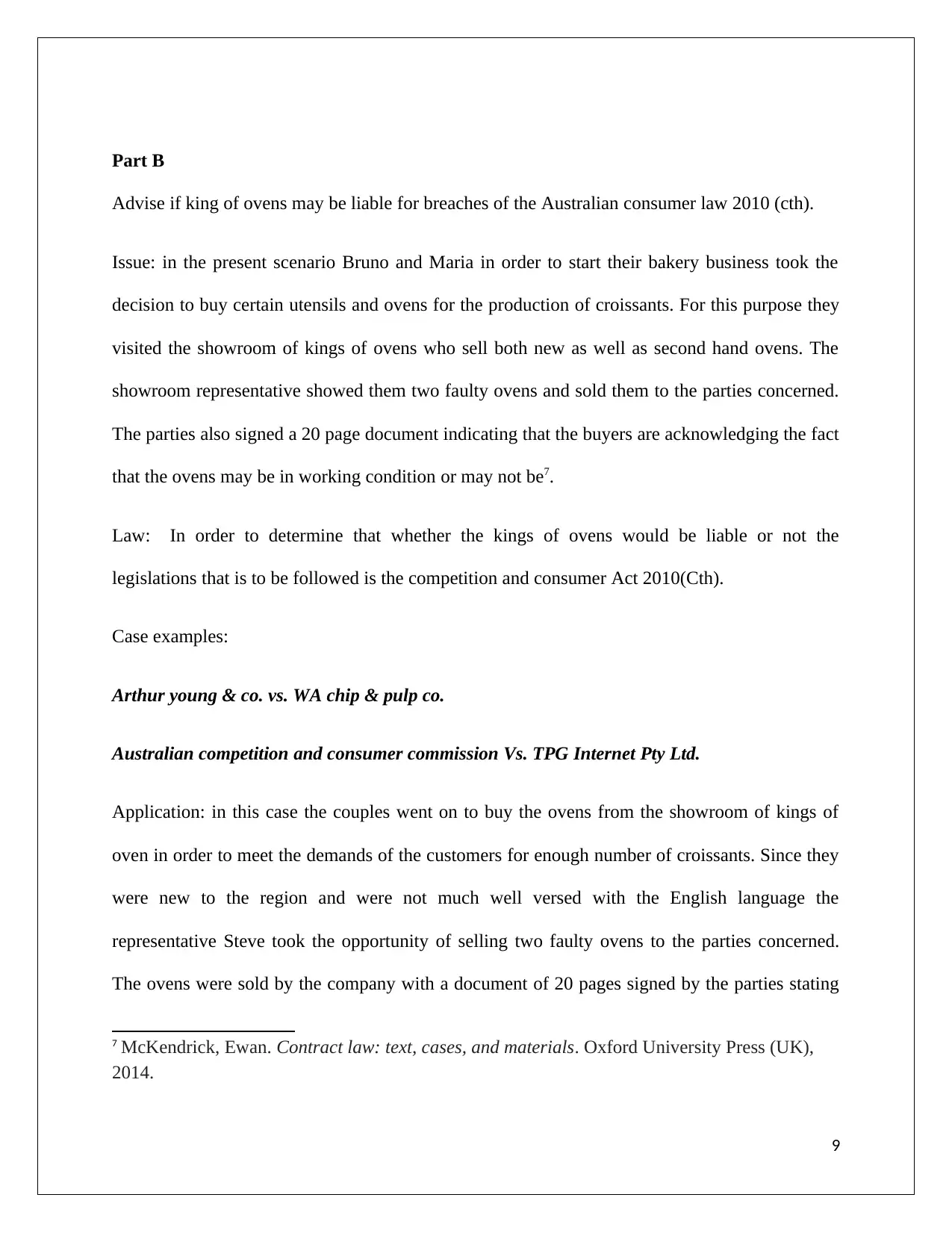
Part B
Advise if king of ovens may be liable for breaches of the Australian consumer law 2010 (cth).
Issue: in the present scenario Bruno and Maria in order to start their bakery business took the
decision to buy certain utensils and ovens for the production of croissants. For this purpose they
visited the showroom of kings of ovens who sell both new as well as second hand ovens. The
showroom representative showed them two faulty ovens and sold them to the parties concerned.
The parties also signed a 20 page document indicating that the buyers are acknowledging the fact
that the ovens may be in working condition or may not be7.
Law: In order to determine that whether the kings of ovens would be liable or not the
legislations that is to be followed is the competition and consumer Act 2010(Cth).
Case examples:
Arthur young & co. vs. WA chip & pulp co.
Australian competition and consumer commission Vs. TPG Internet Pty Ltd.
Application: in this case the couples went on to buy the ovens from the showroom of kings of
oven in order to meet the demands of the customers for enough number of croissants. Since they
were new to the region and were not much well versed with the English language the
representative Steve took the opportunity of selling two faulty ovens to the parties concerned.
The ovens were sold by the company with a document of 20 pages signed by the parties stating
7 McKendrick, Ewan. Contract law: text, cases, and materials. Oxford University Press (UK),
2014.
9
Advise if king of ovens may be liable for breaches of the Australian consumer law 2010 (cth).
Issue: in the present scenario Bruno and Maria in order to start their bakery business took the
decision to buy certain utensils and ovens for the production of croissants. For this purpose they
visited the showroom of kings of ovens who sell both new as well as second hand ovens. The
showroom representative showed them two faulty ovens and sold them to the parties concerned.
The parties also signed a 20 page document indicating that the buyers are acknowledging the fact
that the ovens may be in working condition or may not be7.
Law: In order to determine that whether the kings of ovens would be liable or not the
legislations that is to be followed is the competition and consumer Act 2010(Cth).
Case examples:
Arthur young & co. vs. WA chip & pulp co.
Australian competition and consumer commission Vs. TPG Internet Pty Ltd.
Application: in this case the couples went on to buy the ovens from the showroom of kings of
oven in order to meet the demands of the customers for enough number of croissants. Since they
were new to the region and were not much well versed with the English language the
representative Steve took the opportunity of selling two faulty ovens to the parties concerned.
The ovens were sold by the company with a document of 20 pages signed by the parties stating
7 McKendrick, Ewan. Contract law: text, cases, and materials. Oxford University Press (UK),
2014.
9
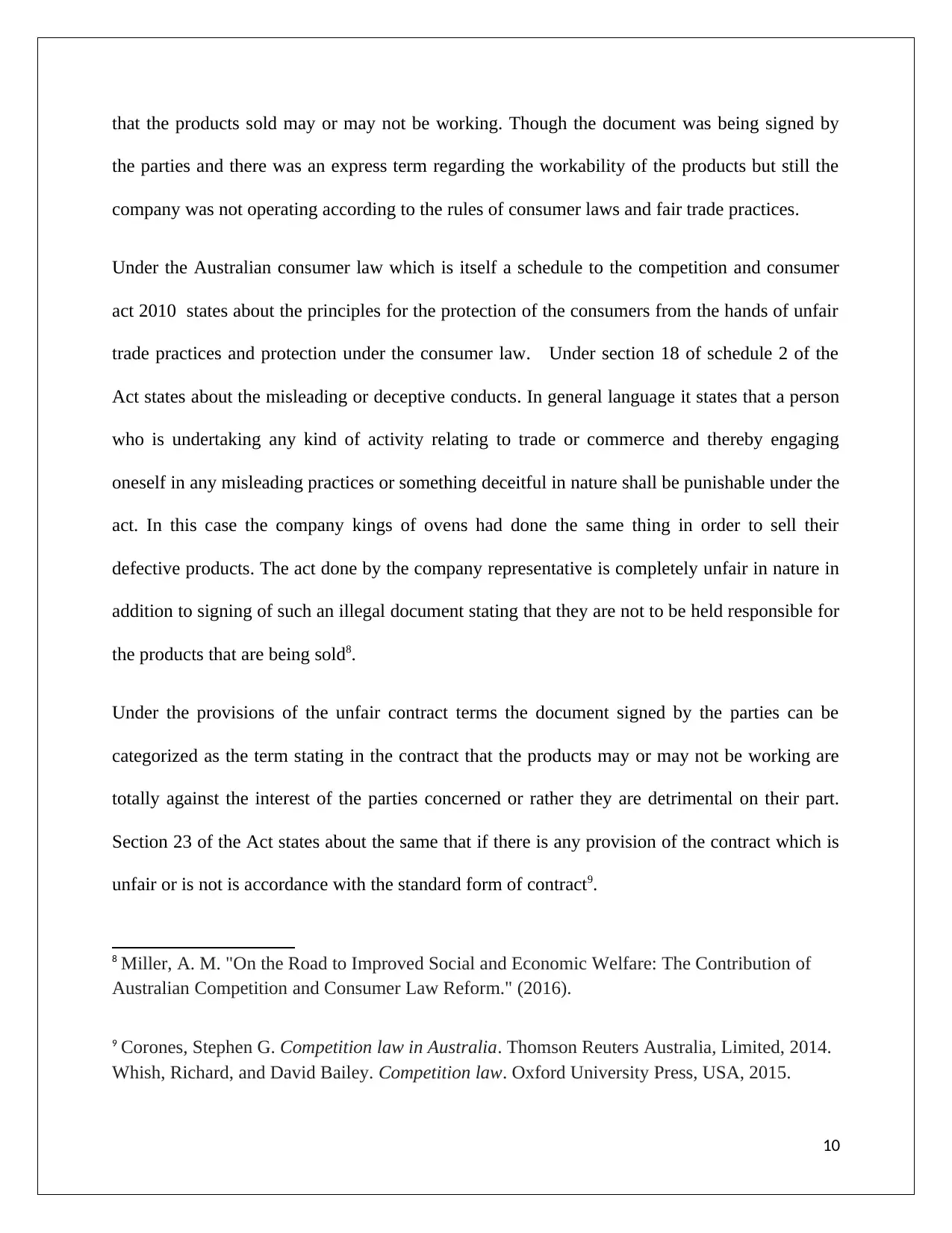
that the products sold may or may not be working. Though the document was being signed by
the parties and there was an express term regarding the workability of the products but still the
company was not operating according to the rules of consumer laws and fair trade practices.
Under the Australian consumer law which is itself a schedule to the competition and consumer
act 2010 states about the principles for the protection of the consumers from the hands of unfair
trade practices and protection under the consumer law. Under section 18 of schedule 2 of the
Act states about the misleading or deceptive conducts. In general language it states that a person
who is undertaking any kind of activity relating to trade or commerce and thereby engaging
oneself in any misleading practices or something deceitful in nature shall be punishable under the
act. In this case the company kings of ovens had done the same thing in order to sell their
defective products. The act done by the company representative is completely unfair in nature in
addition to signing of such an illegal document stating that they are not to be held responsible for
the products that are being sold8.
Under the provisions of the unfair contract terms the document signed by the parties can be
categorized as the term stating in the contract that the products may or may not be working are
totally against the interest of the parties concerned or rather they are detrimental on their part.
Section 23 of the Act states about the same that if there is any provision of the contract which is
unfair or is not is accordance with the standard form of contract9.
8 Miller, A. M. "On the Road to Improved Social and Economic Welfare: The Contribution of
Australian Competition and Consumer Law Reform." (2016).
9 Corones, Stephen G. Competition law in Australia. Thomson Reuters Australia, Limited, 2014.
Whish, Richard, and David Bailey. Competition law. Oxford University Press, USA, 2015.
10
the parties and there was an express term regarding the workability of the products but still the
company was not operating according to the rules of consumer laws and fair trade practices.
Under the Australian consumer law which is itself a schedule to the competition and consumer
act 2010 states about the principles for the protection of the consumers from the hands of unfair
trade practices and protection under the consumer law. Under section 18 of schedule 2 of the
Act states about the misleading or deceptive conducts. In general language it states that a person
who is undertaking any kind of activity relating to trade or commerce and thereby engaging
oneself in any misleading practices or something deceitful in nature shall be punishable under the
act. In this case the company kings of ovens had done the same thing in order to sell their
defective products. The act done by the company representative is completely unfair in nature in
addition to signing of such an illegal document stating that they are not to be held responsible for
the products that are being sold8.
Under the provisions of the unfair contract terms the document signed by the parties can be
categorized as the term stating in the contract that the products may or may not be working are
totally against the interest of the parties concerned or rather they are detrimental on their part.
Section 23 of the Act states about the same that if there is any provision of the contract which is
unfair or is not is accordance with the standard form of contract9.
8 Miller, A. M. "On the Road to Improved Social and Economic Welfare: The Contribution of
Australian Competition and Consumer Law Reform." (2016).
9 Corones, Stephen G. Competition law in Australia. Thomson Reuters Australia, Limited, 2014.
Whish, Richard, and David Bailey. Competition law. Oxford University Press, USA, 2015.
10
Paraphrase This Document
Need a fresh take? Get an instant paraphrase of this document with our AI Paraphraser
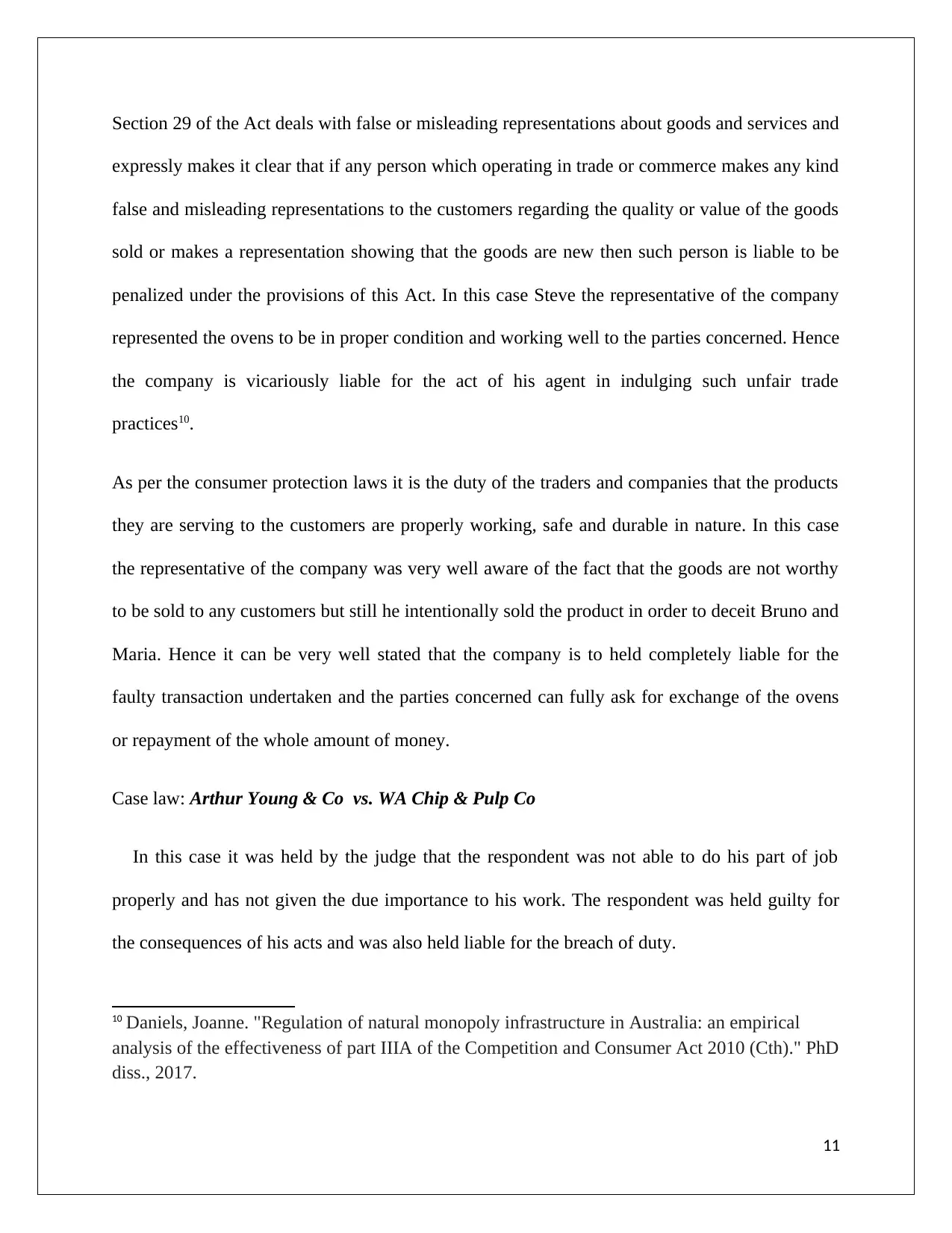
Section 29 of the Act deals with false or misleading representations about goods and services and
expressly makes it clear that if any person which operating in trade or commerce makes any kind
false and misleading representations to the customers regarding the quality or value of the goods
sold or makes a representation showing that the goods are new then such person is liable to be
penalized under the provisions of this Act. In this case Steve the representative of the company
represented the ovens to be in proper condition and working well to the parties concerned. Hence
the company is vicariously liable for the act of his agent in indulging such unfair trade
practices10.
As per the consumer protection laws it is the duty of the traders and companies that the products
they are serving to the customers are properly working, safe and durable in nature. In this case
the representative of the company was very well aware of the fact that the goods are not worthy
to be sold to any customers but still he intentionally sold the product in order to deceit Bruno and
Maria. Hence it can be very well stated that the company is to held completely liable for the
faulty transaction undertaken and the parties concerned can fully ask for exchange of the ovens
or repayment of the whole amount of money.
Case law: Arthur Young & Co vs. WA Chip & Pulp Co
In this case it was held by the judge that the respondent was not able to do his part of job
properly and has not given the due importance to his work. The respondent was held guilty for
the consequences of his acts and was also held liable for the breach of duty.
10 Daniels, Joanne. "Regulation of natural monopoly infrastructure in Australia: an empirical
analysis of the effectiveness of part IIIA of the Competition and Consumer Act 2010 (Cth)." PhD
diss., 2017.
11
expressly makes it clear that if any person which operating in trade or commerce makes any kind
false and misleading representations to the customers regarding the quality or value of the goods
sold or makes a representation showing that the goods are new then such person is liable to be
penalized under the provisions of this Act. In this case Steve the representative of the company
represented the ovens to be in proper condition and working well to the parties concerned. Hence
the company is vicariously liable for the act of his agent in indulging such unfair trade
practices10.
As per the consumer protection laws it is the duty of the traders and companies that the products
they are serving to the customers are properly working, safe and durable in nature. In this case
the representative of the company was very well aware of the fact that the goods are not worthy
to be sold to any customers but still he intentionally sold the product in order to deceit Bruno and
Maria. Hence it can be very well stated that the company is to held completely liable for the
faulty transaction undertaken and the parties concerned can fully ask for exchange of the ovens
or repayment of the whole amount of money.
Case law: Arthur Young & Co vs. WA Chip & Pulp Co
In this case it was held by the judge that the respondent was not able to do his part of job
properly and has not given the due importance to his work. The respondent was held guilty for
the consequences of his acts and was also held liable for the breach of duty.
10 Daniels, Joanne. "Regulation of natural monopoly infrastructure in Australia: an empirical
analysis of the effectiveness of part IIIA of the Competition and Consumer Act 2010 (Cth)." PhD
diss., 2017.
11
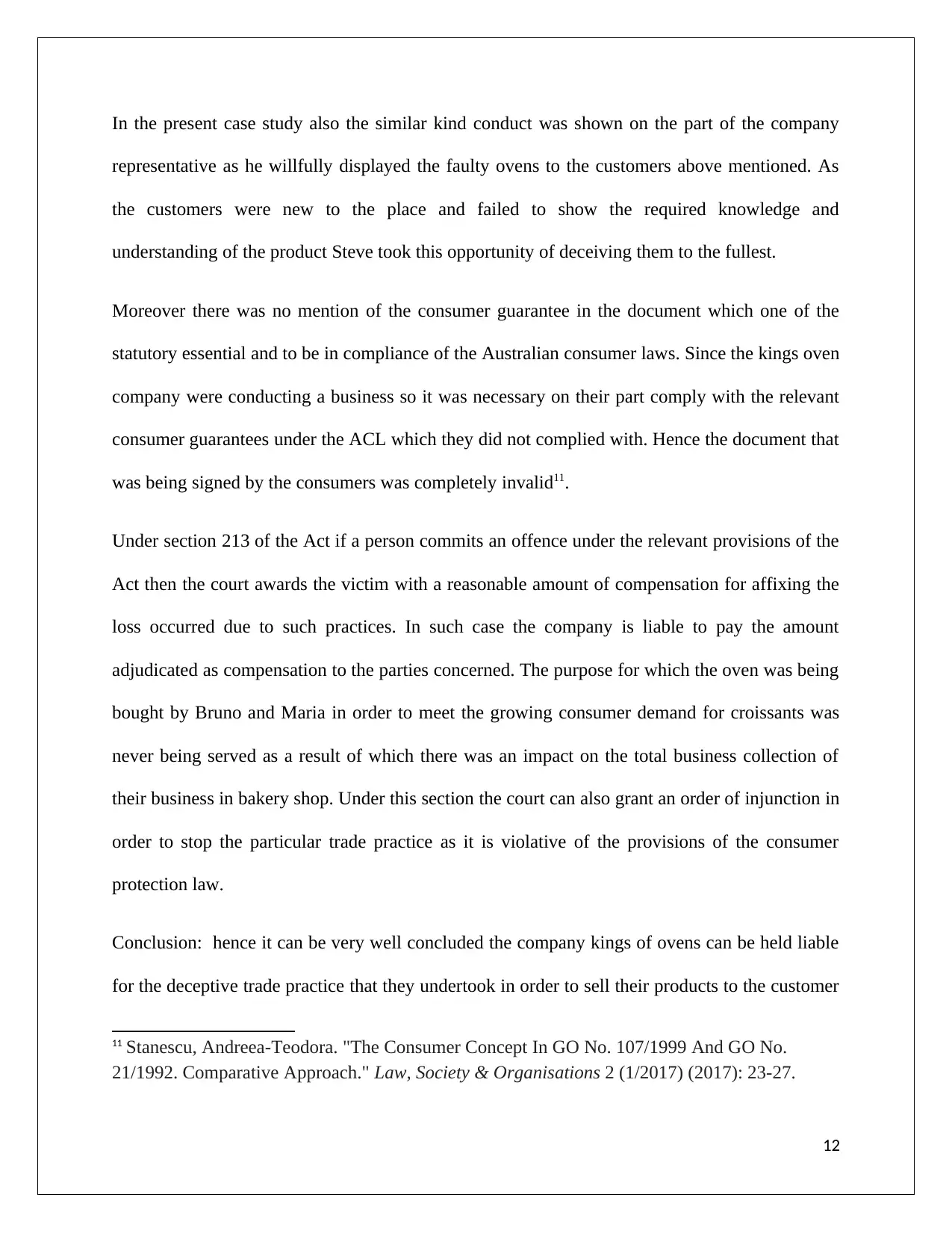
In the present case study also the similar kind conduct was shown on the part of the company
representative as he willfully displayed the faulty ovens to the customers above mentioned. As
the customers were new to the place and failed to show the required knowledge and
understanding of the product Steve took this opportunity of deceiving them to the fullest.
Moreover there was no mention of the consumer guarantee in the document which one of the
statutory essential and to be in compliance of the Australian consumer laws. Since the kings oven
company were conducting a business so it was necessary on their part comply with the relevant
consumer guarantees under the ACL which they did not complied with. Hence the document that
was being signed by the consumers was completely invalid11.
Under section 213 of the Act if a person commits an offence under the relevant provisions of the
Act then the court awards the victim with a reasonable amount of compensation for affixing the
loss occurred due to such practices. In such case the company is liable to pay the amount
adjudicated as compensation to the parties concerned. The purpose for which the oven was being
bought by Bruno and Maria in order to meet the growing consumer demand for croissants was
never being served as a result of which there was an impact on the total business collection of
their business in bakery shop. Under this section the court can also grant an order of injunction in
order to stop the particular trade practice as it is violative of the provisions of the consumer
protection law.
Conclusion: hence it can be very well concluded the company kings of ovens can be held liable
for the deceptive trade practice that they undertook in order to sell their products to the customer
11 Stanescu, Andreea-Teodora. "The Consumer Concept In GO No. 107/1999 And GO No.
21/1992. Comparative Approach." Law, Society & Organisations 2 (1/2017) (2017): 23-27.
12
representative as he willfully displayed the faulty ovens to the customers above mentioned. As
the customers were new to the place and failed to show the required knowledge and
understanding of the product Steve took this opportunity of deceiving them to the fullest.
Moreover there was no mention of the consumer guarantee in the document which one of the
statutory essential and to be in compliance of the Australian consumer laws. Since the kings oven
company were conducting a business so it was necessary on their part comply with the relevant
consumer guarantees under the ACL which they did not complied with. Hence the document that
was being signed by the consumers was completely invalid11.
Under section 213 of the Act if a person commits an offence under the relevant provisions of the
Act then the court awards the victim with a reasonable amount of compensation for affixing the
loss occurred due to such practices. In such case the company is liable to pay the amount
adjudicated as compensation to the parties concerned. The purpose for which the oven was being
bought by Bruno and Maria in order to meet the growing consumer demand for croissants was
never being served as a result of which there was an impact on the total business collection of
their business in bakery shop. Under this section the court can also grant an order of injunction in
order to stop the particular trade practice as it is violative of the provisions of the consumer
protection law.
Conclusion: hence it can be very well concluded the company kings of ovens can be held liable
for the deceptive trade practice that they undertook in order to sell their products to the customer
11 Stanescu, Andreea-Teodora. "The Consumer Concept In GO No. 107/1999 And GO No.
21/1992. Comparative Approach." Law, Society & Organisations 2 (1/2017) (2017): 23-27.
12

and moreover the products were not being up to the level of safety standards that are being stated
by the Act.
13
by the Act.
13
Secure Best Marks with AI Grader
Need help grading? Try our AI Grader for instant feedback on your assignments.
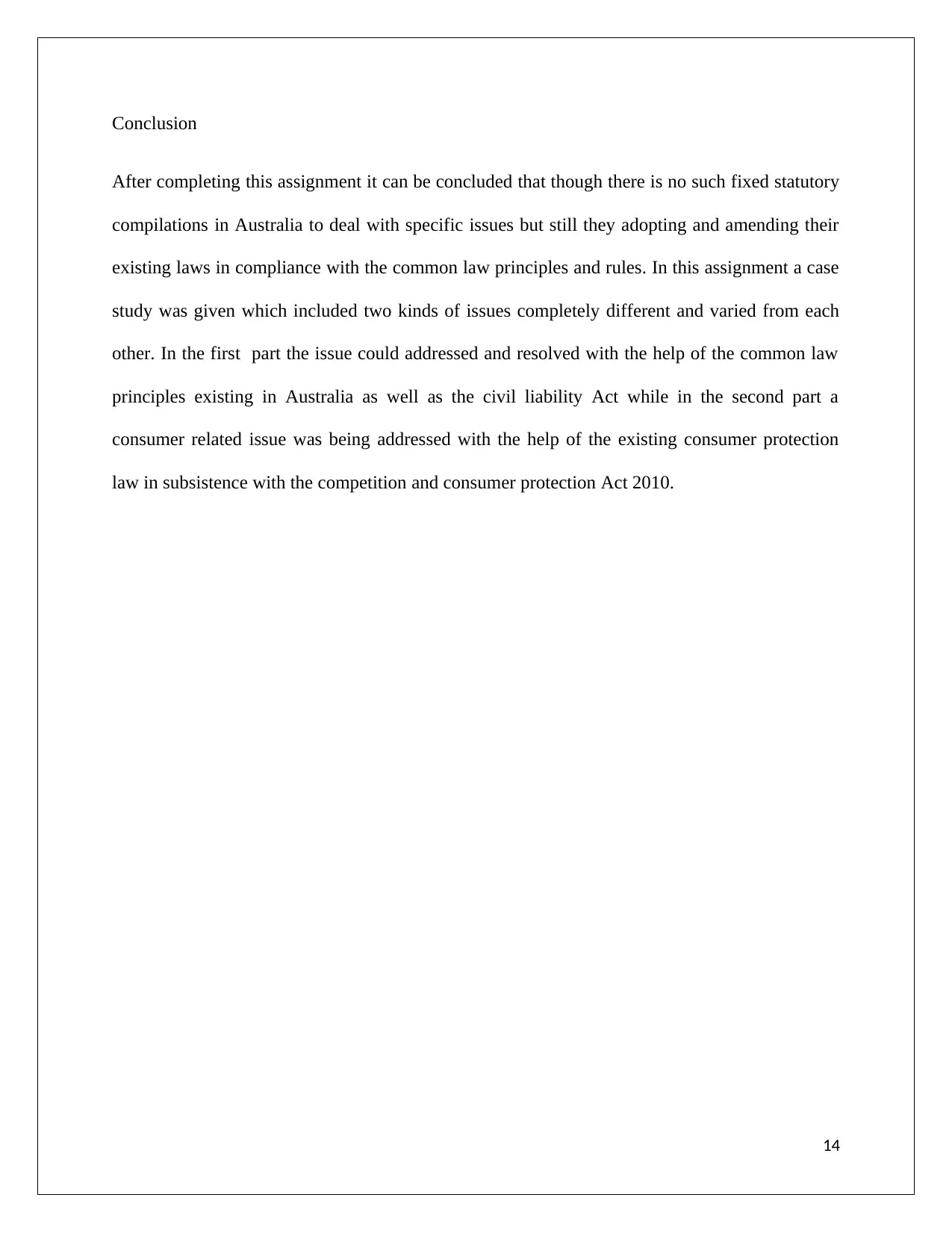
Conclusion
After completing this assignment it can be concluded that though there is no such fixed statutory
compilations in Australia to deal with specific issues but still they adopting and amending their
existing laws in compliance with the common law principles and rules. In this assignment a case
study was given which included two kinds of issues completely different and varied from each
other. In the first part the issue could addressed and resolved with the help of the common law
principles existing in Australia as well as the civil liability Act while in the second part a
consumer related issue was being addressed with the help of the existing consumer protection
law in subsistence with the competition and consumer protection Act 2010.
14
After completing this assignment it can be concluded that though there is no such fixed statutory
compilations in Australia to deal with specific issues but still they adopting and amending their
existing laws in compliance with the common law principles and rules. In this assignment a case
study was given which included two kinds of issues completely different and varied from each
other. In the first part the issue could addressed and resolved with the help of the common law
principles existing in Australia as well as the civil liability Act while in the second part a
consumer related issue was being addressed with the help of the existing consumer protection
law in subsistence with the competition and consumer protection Act 2010.
14
1 out of 14
![[object Object]](/_next/static/media/star-bottom.7253800d.svg)



